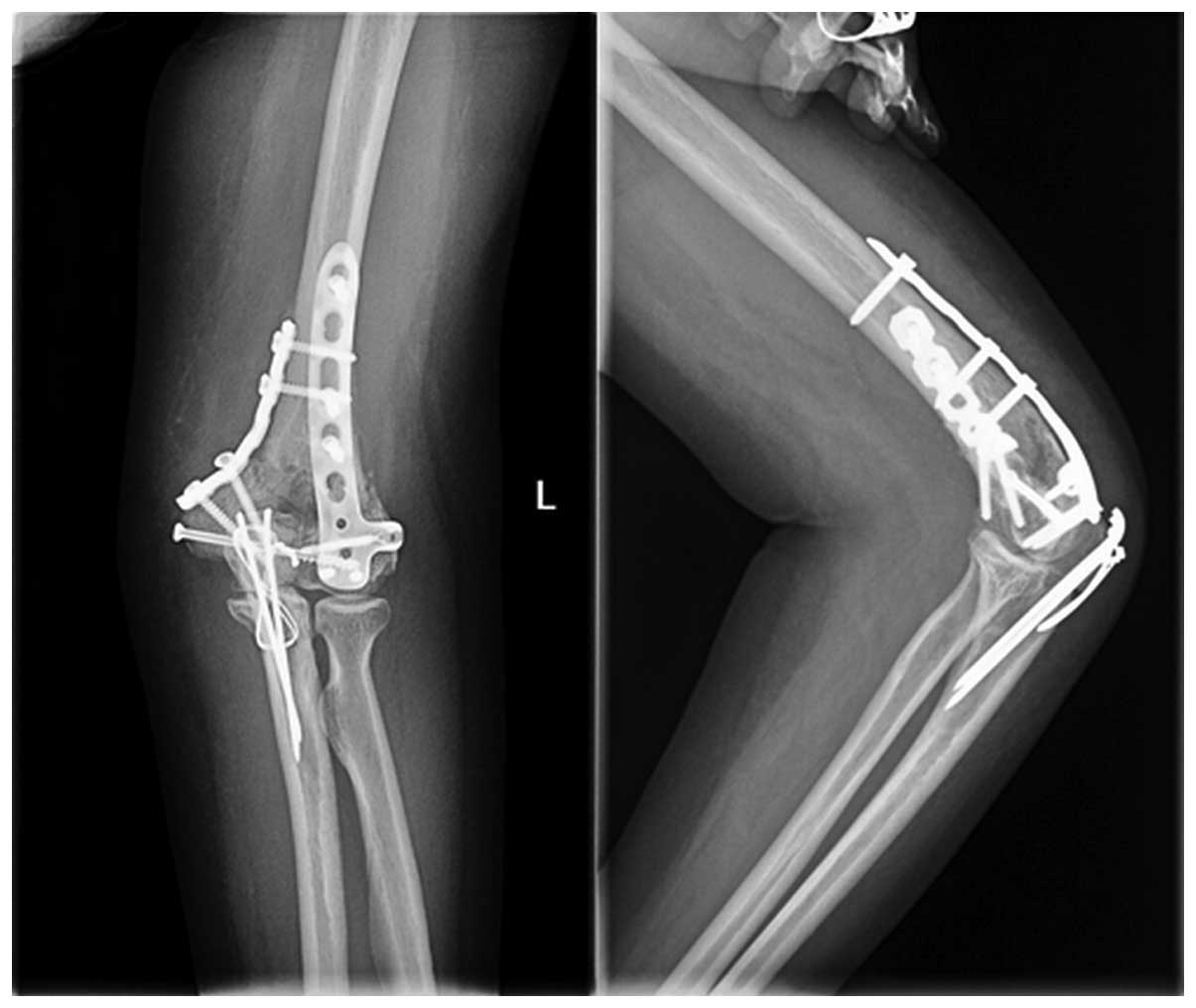|
1.
|
Cannada L, Loeffler B, Zadnik MB and
Eglseder AW: Treatment of high-energy supracondylar/intercondylar
fractures of the distal humerus. J Surg Orthop Adv. 20:230–235.
2011.PubMed/NCBI
|
|
2.
|
Schmidt-Horlohé K, Wilde P, Bonk A, Becker
L and Hoffmann R: One-third tubular-hook-plate osteosynthesis for
olecranon osteotomies in distal humerus type-C fractures: a
preliminary report of results and complications. Injury.
43:295–300. 2012.PubMed/NCBI
|
|
3.
|
Coles CP, Barei DP, Nork SE, Taitsman LA,
Hanel DP and Bradford Henley M: The olecranon osteotomy: a six-year
experience in the treatment of intraarticular fractures of the
distal humerus. J Orthop Trauma. 20:164–171. 2006.PubMed/NCBI
|
|
4.
|
Chen G, Liao Q, Luo W, Li K, Zhao Y and
Zhong D: Triceps-sparing versus olecranon osteotomy for ORIF:
analysis of 67 cases of intercondylar fractures of the distal
humerus. Injury. 42:366–370. 2011. View Article : Google Scholar : PubMed/NCBI
|
|
5.
|
Doornberg JN, van Duijn PJ, Linzel D, et
al: Surgical treatment of intra-articular fractures of the distal
part of the humerus. Functional outcome after twelve to thirty
years. J Bone Joint Surg Am. 89:1524–1532. 2007.PubMed/NCBI
|
|
6.
|
Luegmair M, Timofiey E and Chirpaz-Cerbat
JM: Surgical treatment of AO type C distal humeral fractures:
internal fixation with a Y-shaped reconstruction (Lambda) plate. J
Shoulder Elbow Surg. 17:113–120. 2008. View Article : Google Scholar : PubMed/NCBI
|
|
7.
|
Sanchez-Sotelo J, Torchia ME and
O’Driscoll SW: Complex distal humeral fractures: internal fixation
with a principle-based parallel-plate technique. J Bone Joint Surg
Am. 89:961–969. 2007. View Article : Google Scholar : PubMed/NCBI
|
|
8.
|
Li SH, Li ZH, Cai ZD, et al: Bilateral
plate fixation for type C distal humerus fractures: experience at a
single institution. Int Orthop. 35:433–438. 2011. View Article : Google Scholar
|
|
9.
|
Doğramaci Y, Esen E, Kürklü M, Lirici Y,
Atahan AO and Kömürcü M: Double plate osteosynthesis provides
better biomechanical stabilization than double tension band
technique in distal humerus fractures. Eklem Hastalik Cerrahisi.
21:44–49. 2010.PubMed/NCBI
|
|
10.
|
Schwartz A, Oka R, Odell T and Mahar A:
Biomechanical comparison of two different periarticular plating
systems for stabilization of complex distal humerus fractures. Clin
Biomech (Bristol, Avon). 21:950–955. 2006. View Article : Google Scholar : PubMed/NCBI
|
|
11.
|
Penzkofer R, Hungerer S, Wipf F, von
Oldenburg G and Augat P: Anatomical plate configuration affects
mechanical performance in distal humerus fractures. Clin Biomech
(Bristol, Avon). 25:972–978. 2010. View Article : Google Scholar : PubMed/NCBI
|
|
12.
|
Shin SJ, Sohn HS and Do NH: A clinical
comparison of two different double plating methods for
intraarticular distal humerus fractures. J Shoulder Elbow Surg.
19:2–9. 2010. View Article : Google Scholar : PubMed/NCBI
|
|
13.
|
Müller ME, Nazarian S, Koch P and
Schatzker J: The Comprehensive Classification of Fractures of Long
Bones. 1st edition. Springer-Verlag; Berlin: 1990
|
|
14.
|
Jupiter JB and Morrey BF: Fractures of the
distal humerus in the adult. The Elbow and its Disorders. Morrey
BF: 2nd edition. WB Saunders; Philadelphia: pp. 328–366. 1993
|
|
15.
|
Knirk JL and Jupiter JB: Intra-articular
fractures of the distal end of the radius in young adults. J Bone
Joint Surg Am. 68:647–659. 1986.
|
|
16.
|
Hastings H II and Graham TJ: The
classification and treatment of heterotopic ossification about the
elbow and forearm. Hand Clin. 10:417–437. 1994.PubMed/NCBI
|
|
17.
|
Jeong BO and Lee DK: Treatment for type C
fractures of the distal humerus with the LCP distal humerus system.
Eur J Orthop Surg Traumatol. 22:565–569. 2012. View Article : Google Scholar
|
|
18.
|
Kamrani RS, Mehrpour SR, Aghamirsalim MR,
et al: Pin and plate fixation in complex distal humerus fractures:
surgical technique and results. Int Orthop. 36:839–844. 2012.
View Article : Google Scholar : PubMed/NCBI
|
|
19.
|
Reising K, Hauschild O, Strohm PC and
Suedkamp NP: Stabilisation of articular fractures of the distal
humerus: early experience with a novel perpendicular plate system.
Injury. 40:611–617. 2009. View Article : Google Scholar : PubMed/NCBI
|
|
20.
|
Celli A, Donini MT and Minervini C: The
use of pre-contoured plates in the treatment of C2-C3 fractures of
the distal humerus: clinical experience. Chir Organi Mov. 91:57–64.
2008. View Article : Google Scholar
|
|
21.
|
Arnander MW, Reeves A, MacLeod IA, Pinto
TM and Khaleel A: A biomechanical comparison of plate configuration
in distal humerus fractures. J Orthop Trauma. 22:332–336. 2008.
View Article : Google Scholar : PubMed/NCBI
|
|
22.
|
Gupta R and Khanchandani P: Intercondylar
fracture of the distal humerus in adults: a critical analysis of 55
cases. Injury. 33:511–515. 2002. View Article : Google Scholar : PubMed/NCBI
|
|
23.
|
Gofton WT, Macdermid JC, Patterson SD,
Faber KJ and King GJ: Functional outcome of AO type C distal
humeral fractures. J Hand Surg Am. 28:294–308. 2003. View Article : Google Scholar : PubMed/NCBI
|
|
24.
|
Lim R, Tay SC and Yam A: Radial nerve
injury during double plating of a displaced intercondylar fracture.
J Hand Surg Am. 37:669–672. 2012. View Article : Google Scholar : PubMed/NCBI
|
|
25.
|
Douglas K, Cannada LK, Archer KR, Dean DB,
Lee S and Obremskey W: Incidence and risk factors of heterotopic
ossification following major elbow trauma. Orthopedics. 35:815–822.
2012. View Article : Google Scholar : PubMed/NCBI
|
|
26.
|
Aslam N and Willett K: Functional outcome
following internal fixation of intraarticular fractures of the
distal humerus (AO type C). Acta Orthop Belg. 70:118–122.
2004.PubMed/NCBI
|












